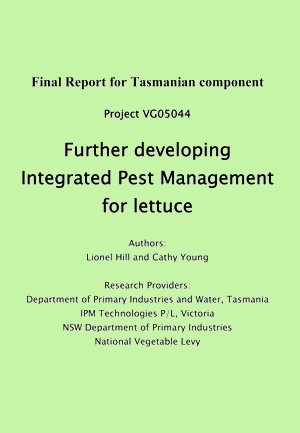|
The pest, currant lettuce aphid caused concern on its arrival in Australia in 2004 because it cannot be controlled by conventional, foliar sprays.
In a Horticulture Australia project in 2004-5 it was controlled in Tasmanian lettuce crops by farmland predatory insects.
The beneficial insects were harnessed by the grower using Integrated Pest Management (IPM) concepts such as sequential, adjacent plantings, looking before spraying and choosing selective or ‘soft’ pesticides as far as possible.
The predators entered lettuce hearts, ate the aphids and moved on before harvest. Insecticidal sprays failed because this pest lives deep inside lettuces unlike other aphids.
A few insecticides are systemic. They travel up the sap of lettuce if drenched around the roots. They kill aphids but not caterpillars. It is feared that their introduction will remove the ‘soft options’ for management of caterpillars.
Caterpillars and aphids share natural predators that die if they eat poisoned aphids – control of one pest does not integrate with control of another.
The use of systemic insecticides against aphids may require a return to hard chemistry against caterpillars. Other pests such as thrips that carry viruses, whiteflies and bugs also complicate the integration of control options.
Authors
|
Lionel Hill
|
Cathy Young
|
Paul Horne
|


Findings :
- In 2004-5 Nasonovia-susceptible iceberg lettuce were grown to commercial standards near Devonport in northern Tasmania without the use of imidacloprid (Confidor®) seedling drenches (Project VG04067).
- The exposure of that success to industry maintained support for continued IPM development in lettuce (initially driven by caterpillar management) despite the appearance of a new pest, the currant lettuce aphid.
- That success did not lead to the immediate, widespread adoption of IPM in Tasmanian or mainland iceberg lettuce but IPM was successfully maintained and adapted by several Victorian growers in 2005-6.
- The success did not convince southern Tasmanian growers that IPM would cope with viral diseases transmitted by thrips (not usually an issue for northern Tasmanian lettuce crops) or with loose-leaf cultivars.
- The current project tested IPM in southern Tasmanians crops of both iceberg and loose-leaf lettuce on the farms of two of the three major growers in the state.
- Good results were obtained in southern iceberg lettuce although intolerable aphid infestation developed in waterlogged sections of the commercial crops such that these sections were bypassed at commercial harvest.
- Poor results were obtained in the loose-leaf crops attributable in part to these crops being 60% faster than iceberg crops.
Predatory insects have less time to follow and overwhelm mobile aphids. There is less room for error in spacing and timing sequential plantings once supplementary sources of predators in the hinterland dry off.
Planting intervals in the current trial were 2-4 weeks whereas one week is not only optimal but closer to commercial practice.
- IPM for iceberg lettuce has now been proven in several Tasmanian and Victorian commercial crops and could be recommended provided experienced IPM advisors supervise it.
- The introduction of bagging iceberg lettuce is distracting from the adoption of IPM in Tasmania.
- Iceberg growers still prefer a strategy based on resistant cultivars but fear that cool season temperate cultivars will be overlooked by commercial breeders.
- IPM for loose-leaf lettuce requires more empirical development. Provision of nursery vegetation for beneficial insects is impeded by 5 shortages of land in winter and complexities of weed and irrigation management. However, shorter (weekly) planting intervals are not only closer to commercial practice but also favoured by IPM theory.
- Loose-leaf growers still prefer a strategy based on resistant cultivars but require cultivars with broad seasonal performance to reduce the necessity for relabelling packages whenever cultivars change.
- Although a thrips-transmitted virus (TSWV) was feared as the major challenge to IPM in southern Tasmanian lettuce the greater challenge may be short crop duration. Also, growers still doubt whether the thrips/virus issue was addressed because they believe virus pressure was low in 2005-6.
- Currant lettuce aphid may be at an advantage over beneficial insects in cool temperate autumn conditions so that professional advice should be taken when extending IPM into autumn and winter.
Acknowledgments :
This project was supported by the National Vegetable Levy and growers Greg Fehlberg and Houstons Farms.
The following entomological staff of DPIW, Tasmania conducted the field observations, sampling and laboratory assessment of lettuce: Lionel Hill, Dr Cathy Young, Graeme Anderson, Wayne Williams, Kellie Gillespie and Michaela Young.
The following owners and staff at Houstons Farm, Richmond provided land, knowledge and resources to grow loose-leaf lettuce: Colin Houston, Dr Lee Peterson, Ricky Munford, Kate Smith and others.
Kate Smith also assisted greatly with field observations and crop records. 21 Greg Fehlberg, owner and operator at Brownwood Farm, Campania provided land, knowledge and resources to grow iceberg lettuce.
Dr Paul Horne and Jessica Page from IPM Technologies P/L provided key professional knowledge and commercial experience in vegetable IPM to the research team and to growers.
The national vegetable levy provided funds for seedlings and towards technical staff and travel for professional staff for this project.
Dr Sandra McDougall of the NSW Department of Primary Industries obtained project funding, provided liaison with Horticulture Australia Limited and AusVeg, professional advice and access to the Lettuce Leaf newsletter.
|

